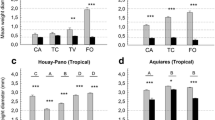Abstract
To assess the possible degree of root competition from fruit trees which could potentially be used in agroforestry systems, fine root density of fruit trees Strychnos cocculoides Bak., Strychnos spinosa Lam. (Loganiaceae) and Vangueria infausta Burch. (Rubiaceae), as well as from the shrubby species, Grewia flava DC. (Tiliaceae) was investigated. Vangueria infausta had the highest fine root densities in both vertical and horizontal extensions. In Vangueria infausta fine root density decreased with increasing soil depth. For the other species in the 80 cm soil profile investigated, no significant changes in fine root density with soil depth were found. For Strychnos cocculoides almost no fine roots were detected in the upper soil horizon (0–20 cm). Using fine root surface area densities, exploration and exploitation indices were calculated. Vangueria infausta had the highest value of the exploration index compared to the other species. For use in agroforestry systems Vangueria infausta was estimated to be the most competitive of the investigated species, whereas Strychnos cocculoides seems to be the less competitive. Strychnos cocculoides has additionally spatial arrangements of fine roots favourable for agroforestry, slowly increasing with depth and additionally low concentrations in upper soil layers.
Similar content being viewed by others
References
G. Berntson (1994) ArticleTitleModelling root architecture: are there tradeoffs between efficiency and potential of resource acquisition? New Phytol. 127 483–493
G. Bohrer V. Kagan-Zur N. Roth-Bejerano D. Ward (2001) ArticleTitleEffects of environmental variables on vesicular–arbuscular mycorrhizal abundance in wild populations of Vangueria infausta J. Veg. Sci. 12 IssueID2 279–288
M. Büsgen (1905) ArticleTitleStudien über die Wurzelsysteme einiger dikotyler Holzpflanzen Flora 95 58–94
G. Cadisch E. Rowe M. van Noordwijk (1997) ArticleTitleNutrient harvesting – the tree-root safety net Agrofor. Forum 8 31–33
W.A. Cannon (1911) The Root Habits of Desert Plants Carnegie Institution of Washington Washington, DC 1–96
J.N. Daniel C.K. Ong M.S. Kumar (1991) ArticleTitleGrowth and resource utilization of perennial pigeonpea (Cajanus cajan (L) Millsp.) at the tree–crop interface Agrofor. Syst. 16 177–192 Occurrence Handle10.1007/BF00119315
A.H. Fitter (1985) Functional significance of root morphology and root system architecture A.H. Fitter D. Atkinson D.J. Read M.B. Usher (Eds) Ecological Interactions in Soil, Special Publication of the British Ecological Society, No. 4 Blackwell Oxford 87–106
A.H. Fitter T.R. Stickland (1991) ArticleTitleArchitectural analysis of plant root systems 2. Influence of nutrient supply on architecture in contrasting plant species New Phytol. 118 383–389
P.W. Gandar K.A. Hughes (1988) ArticleTitleKiwifruit root systems. 1. Root-length densities N. Z. J. Exp. Agirc. 16 35–46
J.H. Graham J.P. Sylvertson (1984) ArticleTitleInfluence of vesicular arbuscular mycorrhiza on the hydraulic conductivity of roots of two citrus rootstocks New Phytol. 97 277–284
K.A. Hughes P.W. Gandar H.N. de Silva (1995) ArticleTitleExploration and exploitation of soil by applekiwifruitpeachAsian pear and grape roots Plant Soil 175 301–309 Occurrence Handle10.1007/BF00011366 Occurrence Handle1:CAS:528:DyaK2MXotFOlur8%3D
N. McKenzie P. Ryan P. Fogarty J. Wood (2001) Sampling, measurement and analytical protocols for carbon estimation in soil, litter and coarse woody debris National Carbon Accounting System Technical Report No. 14 Australian Greenhouse Office Canberra 61
A. Nardini S. Salleo M.T. Tyree M. Vertovec (2000) ArticleTitleInfluence of the ectomycorrhizas formed by Tuber melanosporum Vitt. on hydraulic conductance and water relations of Quercus ilex L. seedlings Ann. Forest Sci. 57 305–312
I. Noy-Meir (1973) ArticleTitleDesert ecosystems: environment and producers Ann. Rev. Ecol. Syst. 4 25–51 Occurrence Handle10.1146/annurev.es.04.110173.000325
C.K. Ong J.E. Corlett R.P. Singh C.R. Black (1991) ArticleTitleAbove and below ground interactions in agroforestry systems Forest Ecol. Manage. 45 45–57
A.L. Oppelt W. Kurth H. Dzierzon G. Jentschke D.L. Godbold (2000) ArticleTitleStructure and fractal dimensions of root systems of four co-occurring fruit tree species from Botswana Ann. Forest Sci. 57 463–475
A.L. Oppelt W. Kurth D.L. Godbold (2001) ArticleTitleTopology, scaling relations and Leonardo’s rule in root systems from African tree species Tree Physiol. 21 117–128 Occurrence Handle1:STN:280:DC%2BD38%2FgslamtQ%3D%3D Occurrence Handle11303642
J.M. Ruiz-Lozano R. Azcon (1995) ArticleTitleHyphal contributions to water uptake in mycorrrhyzal plants as affected by the fungal species and water status Physiologia Plantarum 95 472–478 Occurrence Handle10.1034/j.1399-3054.1995.950320.x Occurrence Handle1:CAS:528:DyaK28XltFKi
S. Schwinning J.R. Ehleringer (2001) ArticleTitleWater use trade-offs and optimal adaptations to pulse-driven arid ecosystems J. Ecol. 89 464–480 Occurrence Handle10.1046/j.1365-2745.2001.00576.x
A. Shmida T.L. Burgess (1988) Plant growth form strategies and vegetation types in arid environments M.J.A. Werger P.J.M.v.d. Aart H.J. During J.T.A. Verhoeven (Eds) Plant Form and Vegetation Structure SPB Academic Publishing The Hague 211–241
S.D. Smith R.K. Monson J.E. Anderson (1997) Physiological Ecology of North American Desert Plants Springer-Verlag Berlin
S.D. Smith P.S. Nobel (1986) Deserts N.R. Baker S.P. Long (Eds) Photosynthesis in Contrasting Environments Elsevier Amsterdam 13–62
InstitutionalAuthorNameSoil Survey Staff (1999) Soil Taxonomy – A Basic System of Soil Classification for Making and Interpreting Soil Surveys, 2nd ed USDA (United States Department of Agriculture), NRCS (Natural Resources Conservation Service) Agriculture Handbook No. 436 Washington, DC 871
M. van Noordwijk G. Lawson A. Soumaré J.J.R. Groot K. Hairiah (1996) Root Distribution of Trees and Crops: Competition and/or Complementarity C.K. Ong P. Huxley (Eds) Tree-Crop Interactions – A Physiological Approach CAB International in Association with ICRAF NairobiKenya 319–364
H. Walter E. Stadelmann (1974) A new approach to the water relations of desert plants R. Brown (Eds) Desert Biology, Vol. 2 Academic Press New York 213–310
Author information
Authors and Affiliations
Corresponding author
Rights and permissions
About this article
Cite this article
Oppelt, A., Kurth, W., Jentschke, G. et al. Contrasting rooting patterns of some arid-zone fruit tree species from Botswana – I. Fine root distribution. Agroforest Syst 64, 1–11 (2005). https://doi.org/10.1007/s10457-005-2402-8
Received:
Accepted:
Issue Date:
DOI: https://doi.org/10.1007/s10457-005-2402-8




